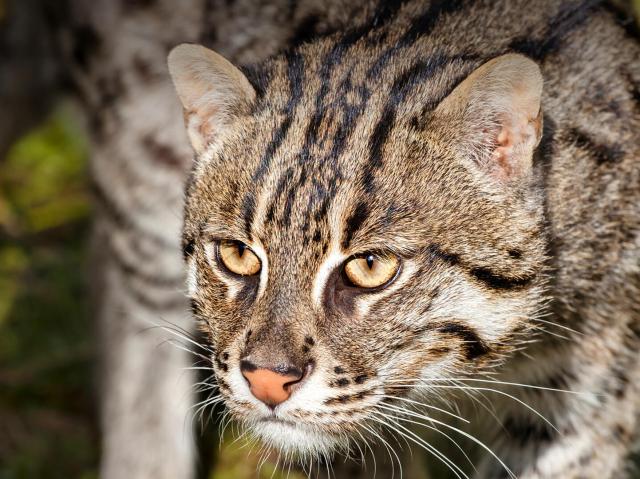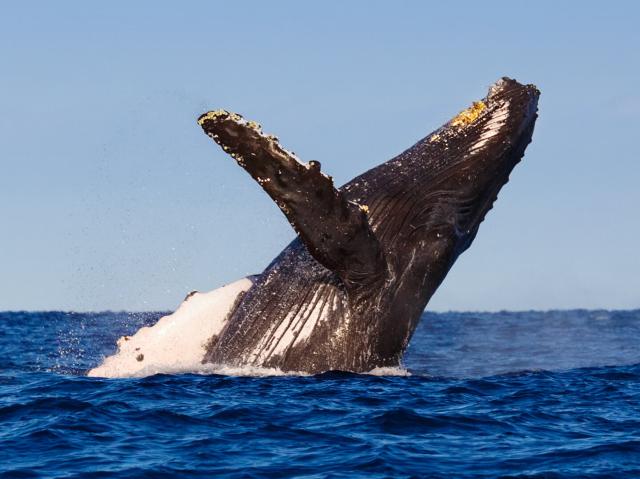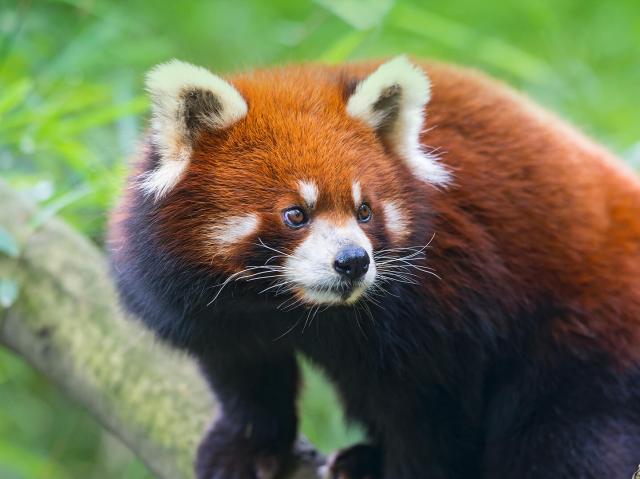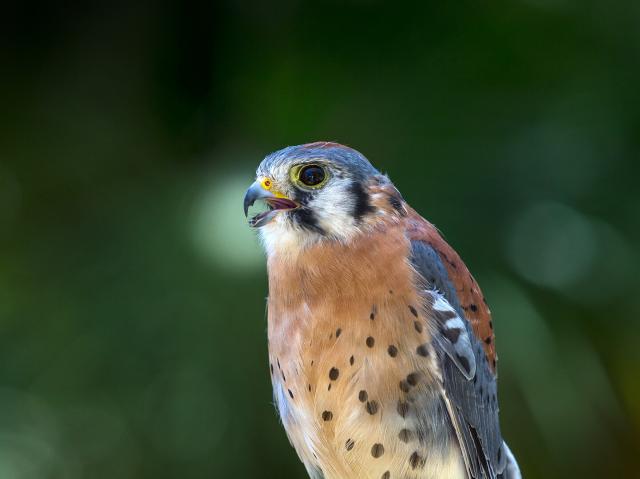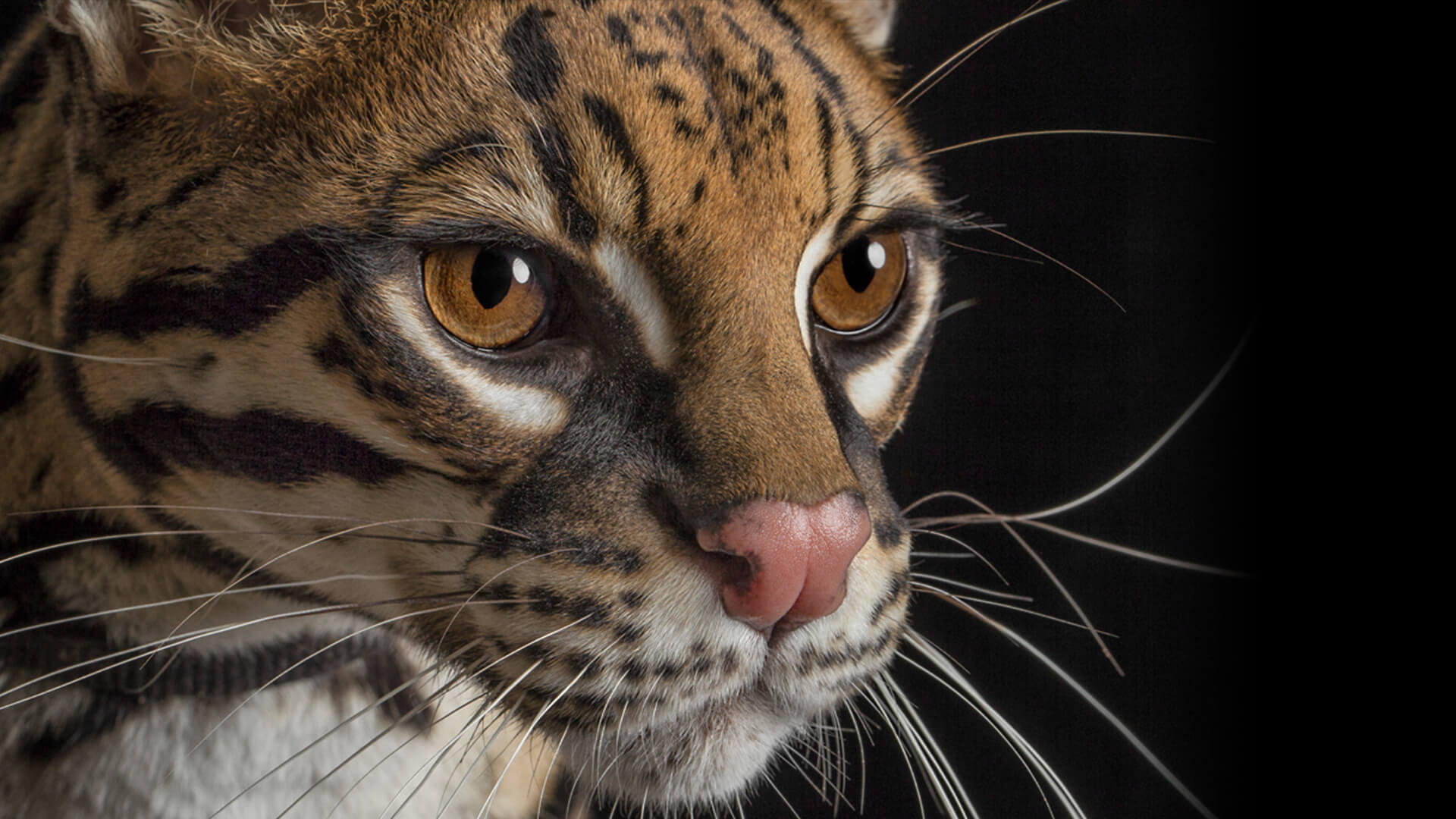
Ocelot

- CLASS: Mammalia (Mammals)
- ORDER: Carnivora
- FAMILY: Felidae
- GENUS: Leopardus
- SPECIES: pardalis

ABOUT
Seeing spots: An ocelot is a small cat from the New World. It ranges from the very southern region of Texas all the way to northern Argentina in South America. The ocelot has one of the most beautiful fur coats in the world. Its fur is golden over most of its body, with white or cream on the belly; splashed over the background color are all sorts of patterns.
Mostly, the ocelot has black or dark brown spots arranged in a doughnut shape, with dark tan in the middle. Sometimes these spots link together and form chains or stripes running along the cat’s sides and back. The ocelot has two stripes on its cheeks and a stripe running from the top of the eye over the head. The eyes also have white fur around them. The tail often has rings around the end and bands closer to the body. Wherever these patterns are missing, the ocelot usually has many small dots and blotches taking up the rest of the space.
Like all small cats, ocelots have very good vision and hearing. Their eyes have a layer that reflects light, so ocelots see much better in the dark than we can. In fact, it is as easy for an ocelot to walk around at night as it is for you to walk around during the day! Their sense of smell is a lot better than ours is, but not as keen as a dog’s. Long whiskers help ocelots feel their way around, too. Although they are predators, ocelots are often harassed by groups of potential prey such as monkeys or birds.
Larger cats such as mountain lions and jaguars may share ocelot habitat, but each cat targets different prey. Still, ocelots may become prey to the larger cats as well as to boa constrictors, anacondas, and harpy eagles.
HABITAT AND DIET
Breakfast at night: It's hard to study wild ocelots, as they are active primarily at night, especially at dawn and dusk, and are very secretive. They may be more active in daytime on rainy or cloudy days. Ocelots prefer to live in areas with thick vegetation, such as dense chaparral or tropical rainforests. During the day, they sleep hidden among bushes, on a tree branch, or inside a hollow tree. Without lots of places to hide, ocelots can't survive. If trees and bushes are cut down in an area where ocelots live, the cats leave.
Ocelots prey mainly on small rodents, but they sometimes they also eat birds, snakes, iguanas and other lizards, baby peccaries, young deer, rabbits, and even fish and crabs. They may look for potential food while strolling about, or may sit and wait for prey to appear. If the carcass can't be eaten in one feeding, the cat covers it and returns the next night to finish its meal. Ocelots spend most of their time on the ground but are strong swimmers and good climbers and jumpers. They may take prey up into a high place to eat it in peace.
FAMILY LIFE
An ocelot family is made up of an adult female and her young. After breeding, the male and female ocelots go their separate ways. The female is pregnant for a little over two months before she gives birth in a hollow tree, rocky bluff, cave, or secluded thicket to usually one but sometimes up to four kittens. The mother protects her kitten, feeds it, and cares for it all by herself. She may move her baby to alternate den sites one to five times, depending on her sense of security.
Young ocelots are fully marked with spots at birth, but their coat is gray, their lower limbs are dark, and their eyes are blue, changing to brown at around three months of age. Those eyes are closed at birth but open at about 14 days. The youngster begins to walk when it is three weeks old. As the kitten grows, the mother ocelot teaches it how to hunt, usually at four to six weeks of age, and the kitten is able to eat solid food at eight weeks, although it may continue to nurse for six months.
By the time it is eight months old, the youngster’s adult teeth are in, and it can hunt for itself, but may stay in the mother's home range for up to two years.
Ocelots communicate with each other using body language, scent marking, and vocalizations. An arched back, stiff legs, and tail held straight down is a threat posture. The cats “chuckle” when excited, may “mutter” to each other, and yowl during courtship.
A male ocelot keeps a territory that overlaps four or five females’ territories, so he can easily find a mate. He is not so friendly to his male next-door neighbors, though: males mark territories and trails by clawing logs, spraying vegetation with their urine, and leaving feces prominently on trails, so all other males know to stay away!
CONSERVATION
In the US, the ocelot used to be found throughout Texas and east to Arkansas and Louisiana, but due to hunting and habitat loss, it is now very rare in this country. There may be as few as 100 ocelots living in the US today. This particular ocelot subspecies, known as the Texas ocelot Leopardus pardalis albescens, is endangered. Otherwise, ocelots are classified as a species of Least Concern on the International Union for Conservation of Nature's (IUCN) Red List of Threatened Species. Ocelots are the most numerous cats in the tropical Americas, but their populations are declining.
Because the ocelot is so gorgeous, people have hunted it for its fur. The skin is usually made into a fur coat, and it can take as many as 25 ocelots to make just one coat. People used to pay more for an ocelot coat than they did for a car! We feel that ocelots look better wearing their fur coat than people do. Luckily, it became illegal to bring ocelots or their skins into the US and other countries in 1972. Since very few people buy the skins anymore, ocelots are not hunted as much as they used to be. However, in many areas they are losing their homes when people clear the land of the brush and forests that ocelots need to survive. Roads built through their ranges leave them vulnerable to being hit by cars.
When you see an ocelot, you may wish that you had one, but wild cats do not make good pets. Some pet ocelots in Florida escaped—or were released when people realized that they are not nice or cuddly—and now live in a small, wild colony. The Association of Zoos and Aquariums has a Species Survival Plan for ocelots.
Sounds
LIFE SPAN
Ocelots in human care have a median life expectancy of 15.7 years.
YOUNG
Gestation: 79 to 82 days
Number of young at birth: 1 to 4 (usually 1)
Weight at birth: 7 to 12 ounces (200 to 340 grams)
Age of maturity: Females 18 to 22 months; males 30 months
SIZE
Length: 29 to 39 inches (73 to 100 centimeters); males are longer than females
Weight: Females 14.5 to 25 pounds (6.6 to 11.3 kilograms); males 15 to 34 pounds (7 to 15.5 kilograms)
Tail length: 10 to 16 inches (26 to 41 centimeters)
FUN FACTS
The ocelot is said to be a picky eater—even more so than other cats. Most cats remove feathers and fur from their prey as they eat it, but ocelots pluck off all the feathers and fur before they start to eat it.
Each ocelot has a different coat pattern.
The right and left side patterns and color of an ocelot’s coat are not the same.
Ocelots are the second-largest spotted cats in South America, after jaguars.
Leopardus pardalis is the taxonomic name for ocelots and means "like a leopard," but there are no leopards where ocelots are found. They got their name from the Aztec word "tlalocelot," which means field tiger.



